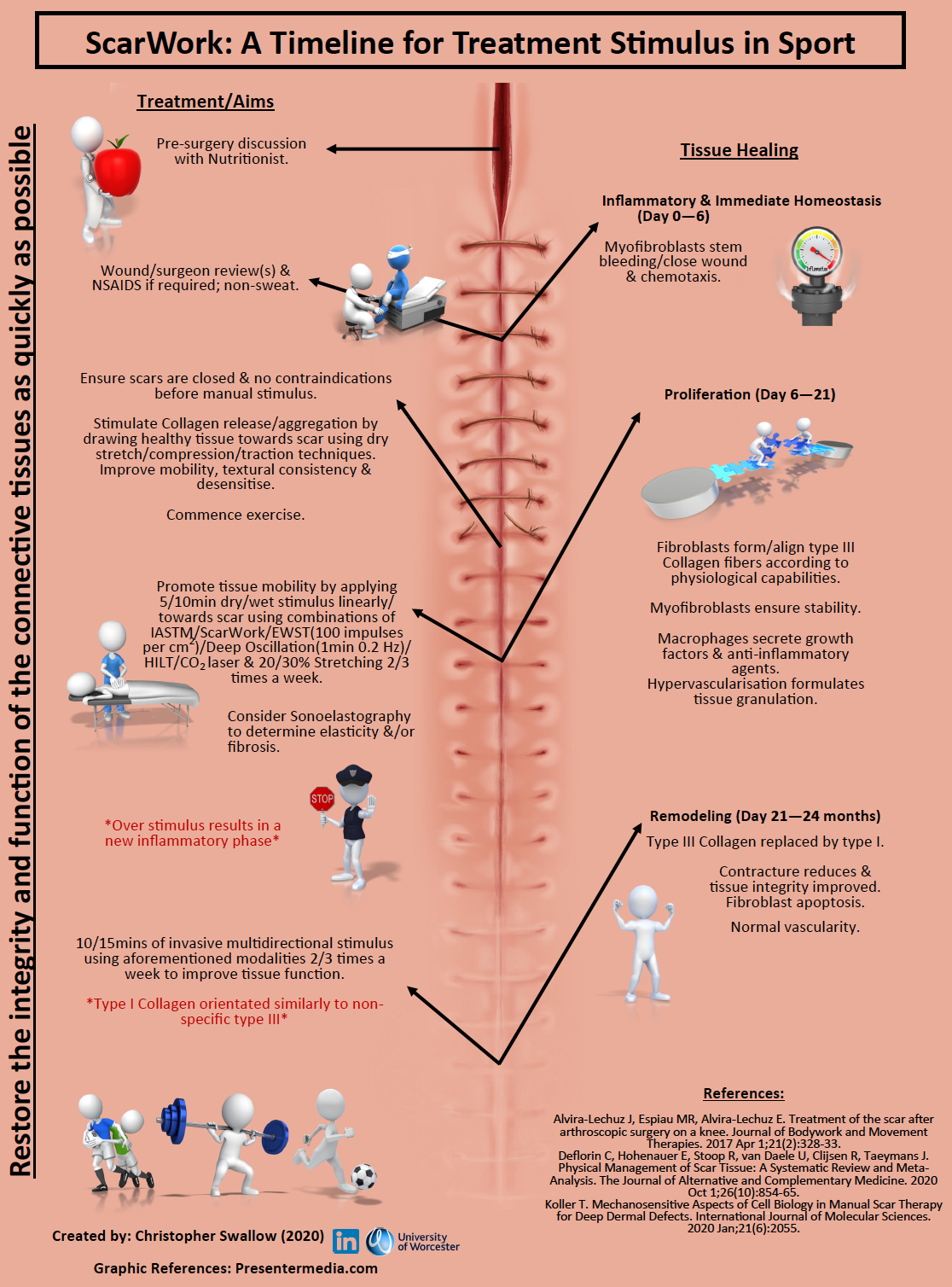The purpose of this infographic is to provide a detailed contextual framework which serves as a tool for medical practitioner reference regarding the approach to and manual treatment of scars and lacerations within a sporting context.
Current pathological literature on the treatment of scars/lacerations is divided. 1 However, it is acknowledged that scars or scar tissue remodeling has greater tensile ‘cytoskeletal’ 2 properties compared to healthy tissue. 3 The inflammatory and immediate homeostasis of normal wound closure and/or tissue healing requires an imbalance within the extracellular matrix (ECM) to effectively produce Collagen; Fibroblasts and Myofibroblasts as well as the stimulation of β1 (TGF-β1) and increased levels of ED-A FN. 2-4 This results in local tissue sequalae, dysfunction and reduced mobility. 3

Accompanied by nutritional strategies, applying complimentary manual and rehabilitative stimulus to the processes of wound healing facilitates the initiation of the correct cellular processes and, hence, is a fundamental requirement for tissue healing. 2, 5
Therefore, as visibly documented, appropriate manual and rehabilitative stimulus has been coordinated to the corresponding stage of tissue healing to restore the integrity and function of the connective tissues as quickly as possible. 2 Practitioners should anecdotally approach and increase dosage, frequency and invasiveness of techniques applied using clinical reasoning on an individual basis depending on scar/laceration maturation/deviation. 2, 5 Utilising combinations of dry/wet stimulus linearly/towards scar using combinations of IASTM; ScarWork; Deep Oscillation (1min 0.2 Hz) (R2); Cupping; Acupuncture (with or without low level voltage or combined with spices), Stretching (2/3 times a week) Extracorporeal Shockwave Therapy (ESWT), High Intensity Light Therapy (HILT) (pulsed dye {PDL} and CO2 laser) have all been discussed in literature. 1-5 Sonoelastography can also be used as a tool to ascertain tissue healing by means of elasticity and/or fibrosis depending on the size and location of the scar/laceration 3 if tissue healing is uncertain or insufficient. Additionally, Bio oil can be administered daily once the wound is closed.
This framework can be applied to various sporting injuries including lacerations or following surgical intervention and resulting in incision/suturing such as: ACL or multi ligament Knee surgery; acute compartment syndrome (ACS); Lattarjet; Lis Franc; Achilles reconstruction; Hamstring; multi ligament Ankle surgery or lacerations caused by training/game trauma.
Please note that the documented stimuli are comprehensive but not exhaustive and are based upon relevant research at the time of submission.
Author and Affiliations:
Christopher Swallow.
School of Sport and Exercise Science, University of Worcester, St John’s Campus, Henwick Grove, Worcester, WR2 6AJ. c.swallow@worc.ac.uk.
References:
- Zanier E, Bordoni B. A multidisciplinary approach to scars: a narrative review. Journal of multidisciplinary healthcare. 2015;8:359.
- Koller T. Mechanosensitive Aspects of Cell Biology in Manual Scar Therapy for Deep Dermal Defects. International Journal of Molecular Sciences. 2020 Jan;21(6):2055.
- Alvira-Lechuz J, Espiau MR, Alvira-Lechuz E. Treatment of the scar after arthroscopic surgery on a knee. Journal of Bodywork and Movement Therapies. 2017 Apr 1;21(2):328-33.
- Tomasek JJ, Gabbiani G, Hinz B, Chaponnier C, Brown RA. Myofibroblasts and mechano-regulation of connective tissue remodelling. Nature reviews Molecular cell biology. 2002 May;3(5):349-63.
- Deflorin C, Hohenauer E, Stoop R, van Daele U, Clijsen R, Taeymans J. Physical Management of Scar Tissue: A Systematic Review and Meta-Analysis. The Journal of Alternative and Complementary Medicine. 2020 Oct 1;26(10):854-65.